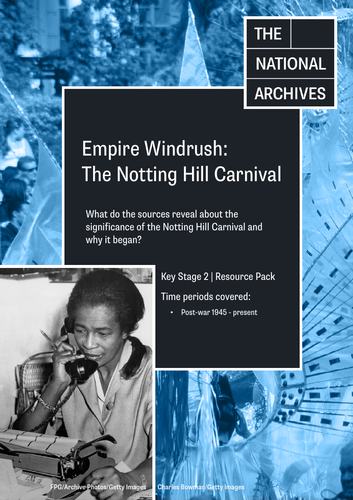

What do the sources reveal about the significance of the Notting Hill Carnival and why it began?
Late 1950s Britain had a growing number of towns and cities that were racially diverse. Notting Hill had become home to lots of people from the Caribbean who had arrived on Windrush and the accompanying ships.
One of these people was Sam Beaver King. He had served for the RAF during the Second World War and after arriving in Britain on the Empire Windrush, he went on to work for the Post Office for over 30 years. He also supported the first Caribbean carnival set up by Claudia Jones in 1959 and went on to become the first black Mayor of Southwark, London in 1983. Sam King co-founded The Windrush Foundation and was awarded an MBE (Member of the Order of the British Empire) in 1998, the year of the 50th anniversary of Windrush.
Yet this multiculturalism was also accompanied by racial tension and the unfair treatment of black people. For example, some white people refused to rent properties to non-white tenants and black people were also sometimes refused service in restaurants and shops. In Notting Hill and the East End of London, there were groups of people who supported far-right policies such as Oswald Moseley’s Union Party, and who attacked and harassed their black neighbours.
In 1958 both the Nottingham Race Riots and the Notting Hill riots took place, as violent fights broke out between white and black people. Amid this hostile atmosphere, Trinidadian human rights activist Claudia Jones organised an indoor Caribbean carnival in Notting Hill on 30th January 1959. She wanted to hold an event that brought people together and celebrated Caribbean culture. This is seen as the start of the Notting Hill Carnival.
Claudia Jones was also the founder and editor of ‘The West Indian Gazette and Afro-Caribbean News. This was viewed as Britain’s first major Black newspaper. Around the same time, political movements, such as the Coloured Peoples Progressive Association and the Association of Advancement of Coloured People, were also established.
In Notting Hill the following year, Kelso Cochrane, a carpenter who had emigrated to Britain from Antigua, was murdered. He had been attacked by a group of white men in Notting Hill, whilst walking home just after midnight. This was a racist murder and not an attempted robbery as claimed by the Police at the time. His death heightened the growing racial tensions that existed.
In 1976 riots occurred at the Notting Hill Carnival when Police and carnival goers clashed. This was against a backdrop of anger surrounding police use of the SUS law. There has been much distrust by carnival goers over time, about the Police’s role and presence at the carnival.
Something went wrong, please try again later.
This resource hasn't been reviewed yet
To ensure quality for our reviews, only customers who have downloaded this resource can review it
Report this resourceto let us know if it violates our terms and conditions.
Our customer service team will review your report and will be in touch.